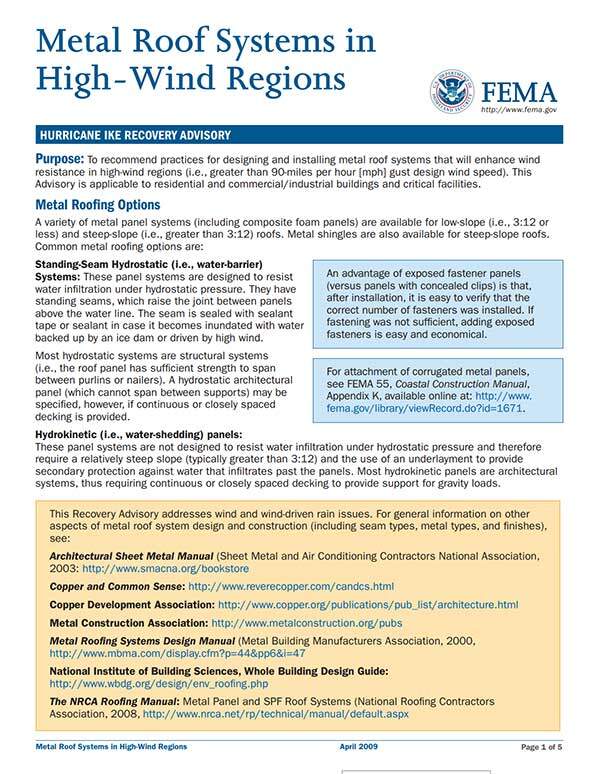After Hurricane Ike wreaked havoc on Galveston, Texas in 2008, FEMA released a report that highlighted the importance of metal roofs in hurricane-prone areas, but with a note of caution. It’s essential to understand that while metal roofs are durable, they aren’t invincible against hurricanes—no roof is. The way a metal roof is installed plays a crucial role in determining its ability to withstand high winds.

FEMA’s Take on Metal Roofs in High Wind Zones
FEMA’s report includes a compelling example: a metal-roofed building that withstood the 170 mph winds of Hurricane Andrew, suffering only minor damage to the hip flashing. This case underscores the resilience of a well-installed metal roof, demonstrating its ability to endure extreme weather conditions.
However, the report also points out several mistakes made during Hurricane Ike that led to roof failures. These include placing clips too far from the eaves, insufficient use of fasteners, wide spacing between fasteners, and selecting roofing systems that didn’t meet the necessary uplift load requirements.
Key Considerations in Storm-Prone Areas
Selecting the right metal roof involves more than just choosing a material. Factors such as roof pitch, building shape, surrounding topography, and proximity to the shoreline all play a role. Local building codes provide guidance on these factors, but it’s also essential to choose materials that suit the specific pitch and slope of your roof.
Once you’ve selected the appropriate roofing material, proper installation is critical for ensuring your roof can withstand heavy winds. Standing-seam roofs generally offer better wind resistance than through-fastened (exposed-fastener) roofs. That said, even a through-fastened roof can perform well if installed with a sufficient number of screws equipped with integral neoprene washers. In storm-prone areas, nailed-down roofs are not advisable.
Tips for Installing Storm-Resistant Metal Roofs
- Use Plenty of Clips and Fasteners: In regions with 110 mph wind ratings, FEMA recommends using two clips along eaves, ridges, and hips. The first eave clip should be placed within 2 to 3 inches of the eave, with the second clip positioned 3 to 4 inches from the first.
- Invest in a Strong Underlayment System: A robust underlayment not only protects your home if panels are blown off but also helps reduce noise during heavy rain.
- Opt for Heavy-Gauge, Narrower Roofing: This choice provides better resistance against wind damage.
- Correctly Space Clips: For concealed clips over a solid substrate, FEMA advises using chalk lines to ensure proper spacing.
- Secure Flashings with Exposed Fasteners: For hip, ridge, and rake flashings, install two rows of fasteners on either side of the hip or ridge line, spacing the rows 3 to 6 inches apart for optimal protection.
- Choose Stainless Steel for Coastal Areas: If your roof is within 3,000 feet of the shoreline, stainless steel clips and fasteners are recommended.
- Use Sealants and Adhesives: These are essential for enhancing wind resistance, particularly along flashings.
The Bottom Line
No matter how many fasteners you use, the strength of your roof ultimately depends on the sub-structural decking and framing. Ensure you use thick wood or metal decking and install sturdy 2×4 purlins (open framing) close together to provide a solid base for attaching your metal roof. Proper installation is your best defense against the powerful winds of Pacific storms.


